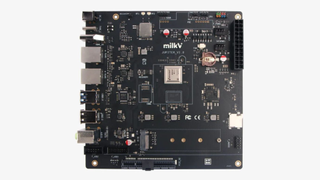RISC-V CPU comes to a mini-ITX motherboard — Jupiter features a SpacemiT K1/M1 chip with 2 TOPS of AI performance
It won't power your next gaming rig but will provide 2 TOPS of AI power.

Milk-V has announced the Jupiter, a mini-ITX motherboard with a RISC-V processor pre-installed. A respected vendor of microcontrollers and RISC-V products, Milk-V brings "RISC-V for everyone" with Jupiter, which will ship soon.
At the Milk-V Jupiter's core is the SpacemiT K1 or M1 processor, a duo of processors powered by eight SpacemiT X60 CPU cores. Specs on the processors and their cores differ based on your source; our best estimation is that the K1 and M1 are virtually identical CPUs running their cores between 1.6 and 2.4 GHz. The processors both contain 819 MHz Imagination BXE-2-32 graphics with Vulkan 1.3 and OpenCL 3.0 support and can produce 2 TOPS of AI performance.
The Jupiter will come with either 4GB, 8GB, or 16GB of LPDDR4X soldered memory. It also supports M.2 drives as long as the M.2 2280 form factor on a PCIe 2.0 bus — limiting speeds to 500 MB/s — alongside a microSD reader and eMMC connector. Jupiter provides a PCIe 2.0 x8 slot for other connectivity, providing space for a slower graphics card or more storage expansion.
At a standard 170 x 170mm mini-ITX form factor, the board provides all the standard I/O you'll use to build a machine. Motherboard headers include 2x USB 3.0 and 2x USB 2.0 and the standard front panel connectors, plus typical ATX 24-pin power, SATA power, and PWM fan headers (no RGB headers, a real shame for the board's target demographic). Rear-panel I/O is listed below.
- 1 x USB 2.0 Type-C
- 2 x USB 3.0 Type-A ports
- 2 x USB 2.0 Type-A ports
- 1 x HDMI (up to 1920 x 1440 pixels @ 60 Hz)
- 2 x Gigabit Ethernet
- 1 x 3.5mm headphone
- 1 x 3.5mm microphone
- 1 x 12V DC power input
Milk-V's Jupiter is a silly method to bring RISC-V to the mainstream, but it stands a chance. A computer built on Jupiter will natively support only the Ubuntu and Fedora distros of Linux, leaving the average Windows or MacOS user in the dust. And while the CPU's 2 TOPS and 50 kDMIPS performance is far from impressive (when was the last time you saw a company advertise with kDMIPS?), the machine may appeal to enthusiasts as a NAS with its CASA OS support.
Currently, Milk-V's website only lists shipping options to China, but the company's X (formerly Twitter) has confirmed U.S./worldwide shipping to begin in the first week of July. Most RISC-V fans will be looking past Jupiter to the release of the Milk-V Oasis, a similar upcoming mini-ITX product expected to offer performance orders of magnitude beyond Jupiter's. RISC-V's continued steady growth thanks to the AI bubble and the growing success of Arm-based processors will continue to provide dividends to low-power computing fans.
Stay On the Cutting Edge: Get the Tom's Hardware Newsletter
Get Tom's Hardware's best news and in-depth reviews, straight to your inbox.

Dallin Grimm is a contributing writer for Tom's Hardware. He has been building and breaking computers since 2017, serving as the resident youngster at Tom's. From APUs to RGB, Dallin has a handle on all the latest tech news.
-
ezst036 Looks somewhat promising. And here I was just complaining about the lack of boards. Heh whoops.Reply
It's not CPU-socketed, nor does it have a PCI-e 16x on it, but gotta start somewhere.
Anybody know the performance equivalent of a SPACEMIT K1/M1 X60? Is that like using a Tualatin P3 or maybe a first-gen Ryzen? -
In one Geekbench 5 entry, the spacemit k1 scored the following. So you can now guess how much performance it can offer as compared to other processors.Reply
84, Single-Core Score
497, Multi-Core Score . -
Findecanor Reply
The SpacemiT X60 core is in-order dual-issue, similar to the ARM Cortex-A53 in the Raspberry Pi 3.ezst036 said:Anybody know the performance equivalent of a SPACEMIT K1/M1 X60? Is that like using a Tualatin P3 or maybe a first-gen Ryzen?
However, it has 2×128 vector units (supporting 256-bit vectors) which can run in parallel to the fp unit, whereas the A53 is more like 2×64 which can do either two fp or one 128-bit vector operation per cycle.
The K1 has eight cores though, compared to four in the Raspberry Pi 3's SoC.
Half the cores in the K1 has SpacemiT's proprietary AI instructions (matrix multiplication).
Otherwise, I think the big point for RISC-V fans is that it is RVA22 profile compliant, and has Vector 1.0 — and those are bound to be the new baseline in functionality for future RISC-V application processors.
The benchmarks I've seen so far haven't been compiled for RVA22, so they don't show the CPU's full potential.
They should be marginally better. -
ThomasKinsley This is Raspberry Pi-level territory: interesting for development, but not particularly useful otherwise. To put this in perspective, 5 year old smartphone processors, such as the Snapdragon 855, produce ~7 TOPS (current gen smartphones produce 30+), and they are smaller than ITX boards.Reply -
subspruce RISC-V is not there, yet, but this is what mini-ITX was originally for back when it was released by VIAReply